wheel size MINI Hardtop 2 Door 2007 Owner's Manual
[x] Cancel search | Manufacturer: MINI, Model Year: 2007, Model line: Hardtop 2 Door, Model: MINI Hardtop 2 Door 2007Pages: 148, PDF Size: 2.43 MB
Page 88 of 148
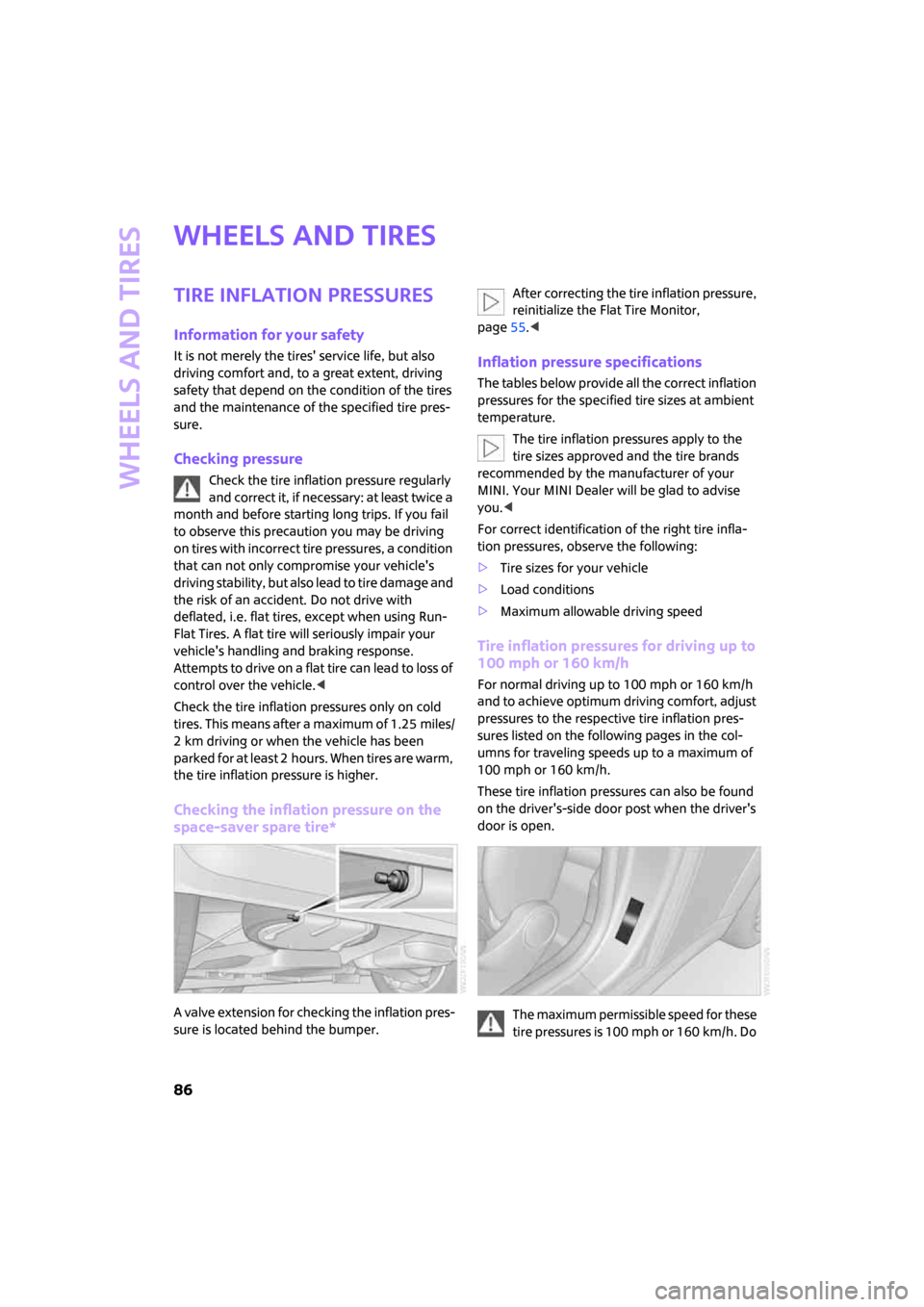
Wheels and tires
86
Wheels and tires
Tire inflation pressures
Information for your safety
It is not merely the tires' service life, but also
driving comfort and, to a great extent, driving
safety that depend on the condition of the tires
and the maintenance of the specified tire pres-
sure.
Checking pressure
Check the tire inflation pressure regularly
and correct it, if necessary: at least twice a
month and before starting long trips. If you fail
to observe this precaution you may be driving
on tires with incorrect tire pressures, a condition
that can not only compromise your vehicle's
driving stability, but also lead to tire damage and
the risk of an accident. Do not drive with
deflated, i.e. flat tires, except when using Run-
Flat Tires. A flat tire will seriously impair your
vehicle's handling and braking response.
Attempts to drive on a flat tire can lead to loss of
control over the vehicle.<
Check the tire inflation pressures only on cold
tires. This means after a maximum of 1.25 miles/
2 km driving or when the vehicle has been
parked for at least 2 hours. When tires are warm,
the tire inflation pressure is higher.
Checking the inflation pressure on the
space-saver spare tire*
A valve extension for checking the inflation pres-
sure is located behind the bumper.After correcting the tire inflation pressure,
reinitialize the Flat Tire Monitor,
page55.<
Inflation pressure specifications
The tables below provide all the correct inflation
pressures for the specified tire sizes at ambient
temperature.
The tire inflation pressures apply to the
tire sizes approved and the tire brands
recommended by the manufacturer of your
MINI. Your MINI Dealer will be glad to advise
you.<
For correct identification of the right tire infla-
tion pressures, observe the following:
>Tire sizes for your vehicle
>Load conditions
>Maximum allowable driving speed
Tire inflation pressures for driving up to
100 mph or 160 km/h
For normal driving up to 100 mph or 160 km/h
and to achieve optimum driving comfort, adjust
pressures to the respective tire inflation pres-
sures listed on the following pages in the col-
umns for traveling speeds up to a maximum of
100 mph or 160 km/h.
These tire inflation pressures can also be found
on the driver's-side door post when the driver's
door is open.
The maximum permissible speed for these
tire pressures is 100 mph or 160 km/h. Do
Page 90 of 148
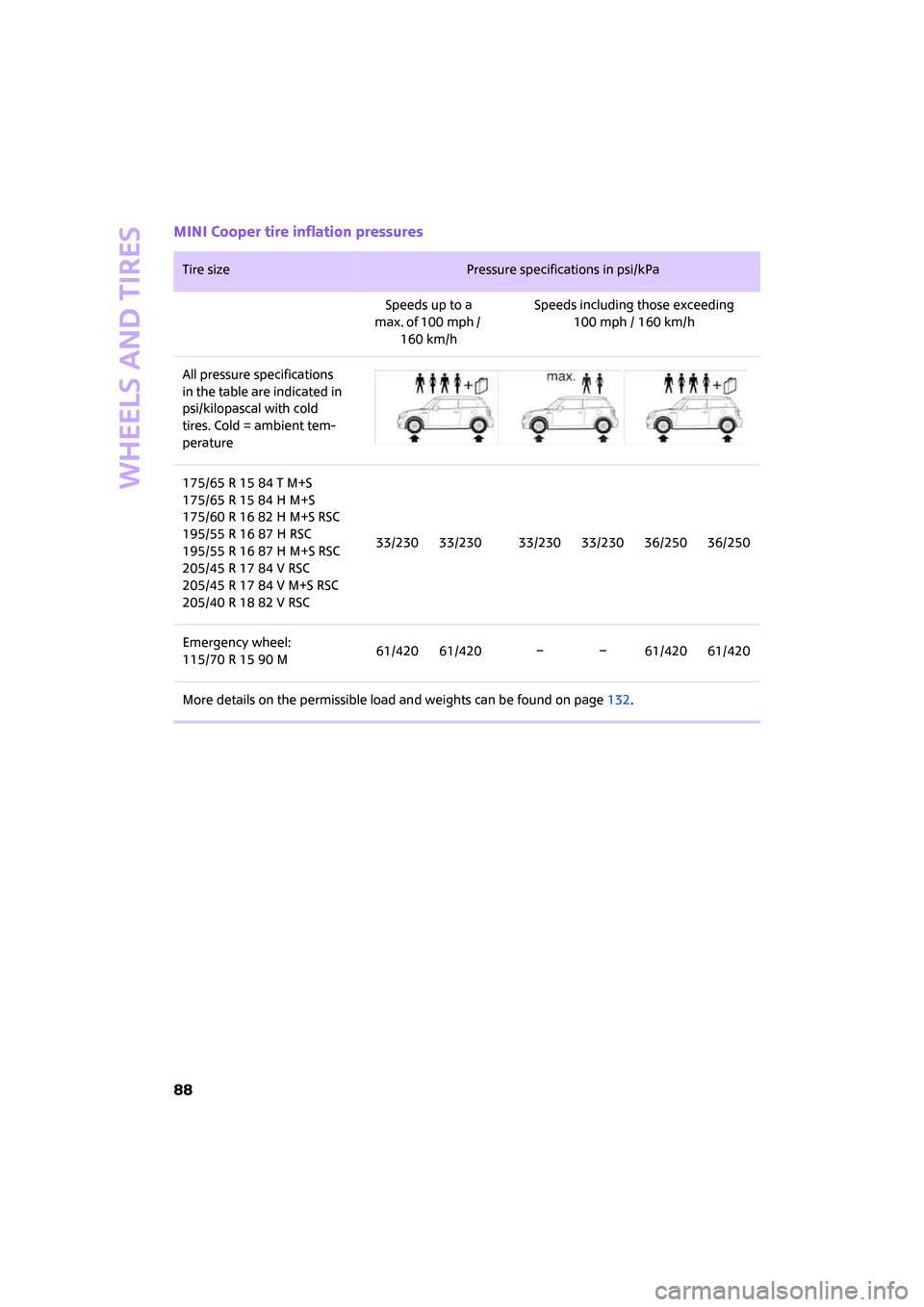
Wheels and tires
88
MINI Cooper tire inflation pressures
Tire size Pressure specifications in psi/kPa
Speeds up to a
max. of 100 mph /
160 km/hSpeeds including those exceeding
100 mph / 160 km/h
All pressure specifications
in the table are indicated in
psi/kilopascal with cold
tires. Cold = ambient tem-
perature
175/65 R 15 84 T M+S
175/65 R 15 84 H M+S
175/60 R 16 82 H M+S RSC
195/55 R 16 87 H RSC
195/55 R 16 87 H M+S RSC
205/45 R 17 84 V RSC
205/45 R 17 84 V M+S RSC
205/40 R 18 82 V RSC33/230 33/230 33/230 33/230 36/250 36/250
Emergency wheel:
115/70 R 15 90 M61/420 61/420 – – 61/420 61/420
More details on the permissible load and weights can be found on page132.
Page 92 of 148
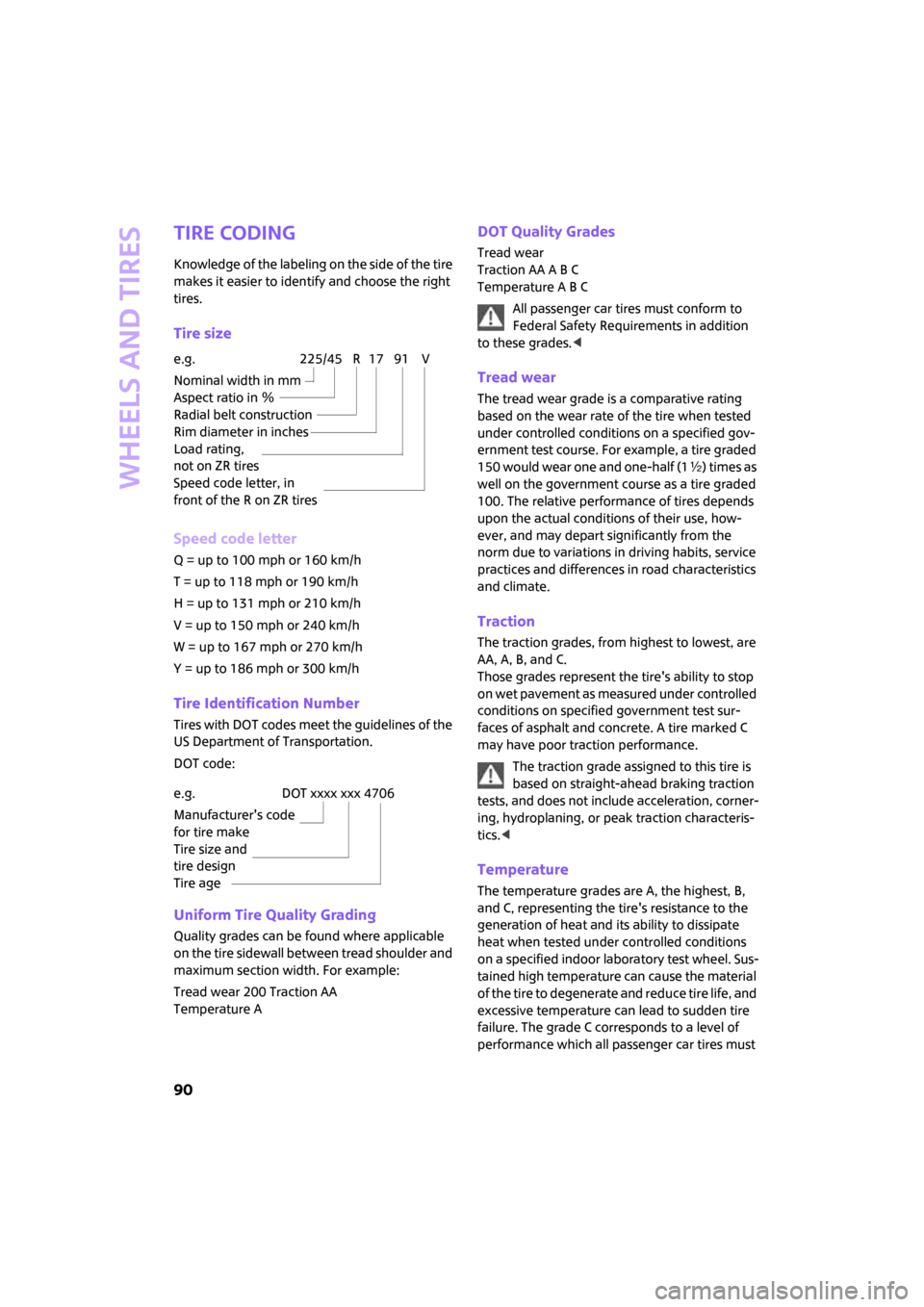
Wheels and tires
90
Tire coding
Knowledge of the labeling on the side of the tire
makes it easier to identify and choose the right
tires.
Tire size
Speed code letter
Q = up to 100 mph or 160 km/h
T = up to 118 mph or 190 km/h
H = up to 131 mph or 210 km/h
V = up to 150 mph or 240 km/h
W = up to 167 mph or 270 km/h
Y = up to 186 mph or 300 km/h
Tire Identification Number
Tires with DOT codes meet the guidelines of the
US Department of Transportation.
DOT code:
Uniform Tire Quality Grading
Quality grades can be found where applicable
on the tire sidewall between tread shoulder and
maximum section width. For example:
Tread wear 200 Traction AA
Temperature A
DOT Quality Grades
Tread wear
Traction AA A B C
Temperature A B C
All passenger car tires must conform to
Federal Safety Requirements in addition
to these grades.<
Tread wear
The tread wear grade is a comparative rating
based on the wear rate of the tire when tested
under controlled conditions on a specified gov-
ernment test course. For example, a tire graded
150 would wear one and one-half (1γ) times as
well on the government course as a tire graded
100. The relative performance of tires depends
upon the actual conditions of their use, how-
ever, and may depart significantly from the
norm due to variations in driving habits, service
practices and differences in road characteristics
and climate.
Traction
The traction grades, from highest to lowest, are
AA, A, B, and C.
Those grades represent the tire's ability to stop
on wet pavement as measured under controlled
conditions on specified government test sur-
faces of asphalt and concrete. A tire marked C
may have poor traction performance.
The traction grade assigned to this tire is
based on straight-ahead braking traction
tests, and does not include acceleration, corner-
ing, hydroplaning, or peak traction characteris-
tics.<
Temperature
The temperature grades are A, the highest, B,
and C, representing the tire's resistance to the
generation of heat and its ability to dissipate
heat when tested under controlled conditions
on a specified indoor laboratory test wheel. Sus-
tained high temperature can cause the material
of the tire to degenerate and reduce tire life, and
excessive temperature can lead to sudden tire
failure. The grade C corresponds to a level of
performance which all passenger car tires must e.g.
Nominal width in mm
Aspect ratio in Ξ
Radial belt construction
Rim diameter in inches
Load rating,
not on ZR tires
Speed code letter, in
front of the R on ZR tires
225/45 R 17 91 V
e.g.
Manufacturer's code
for tire make
Tire size and
tire design
Tire ageDOT xxxx xxx 4706
Page 94 of 148
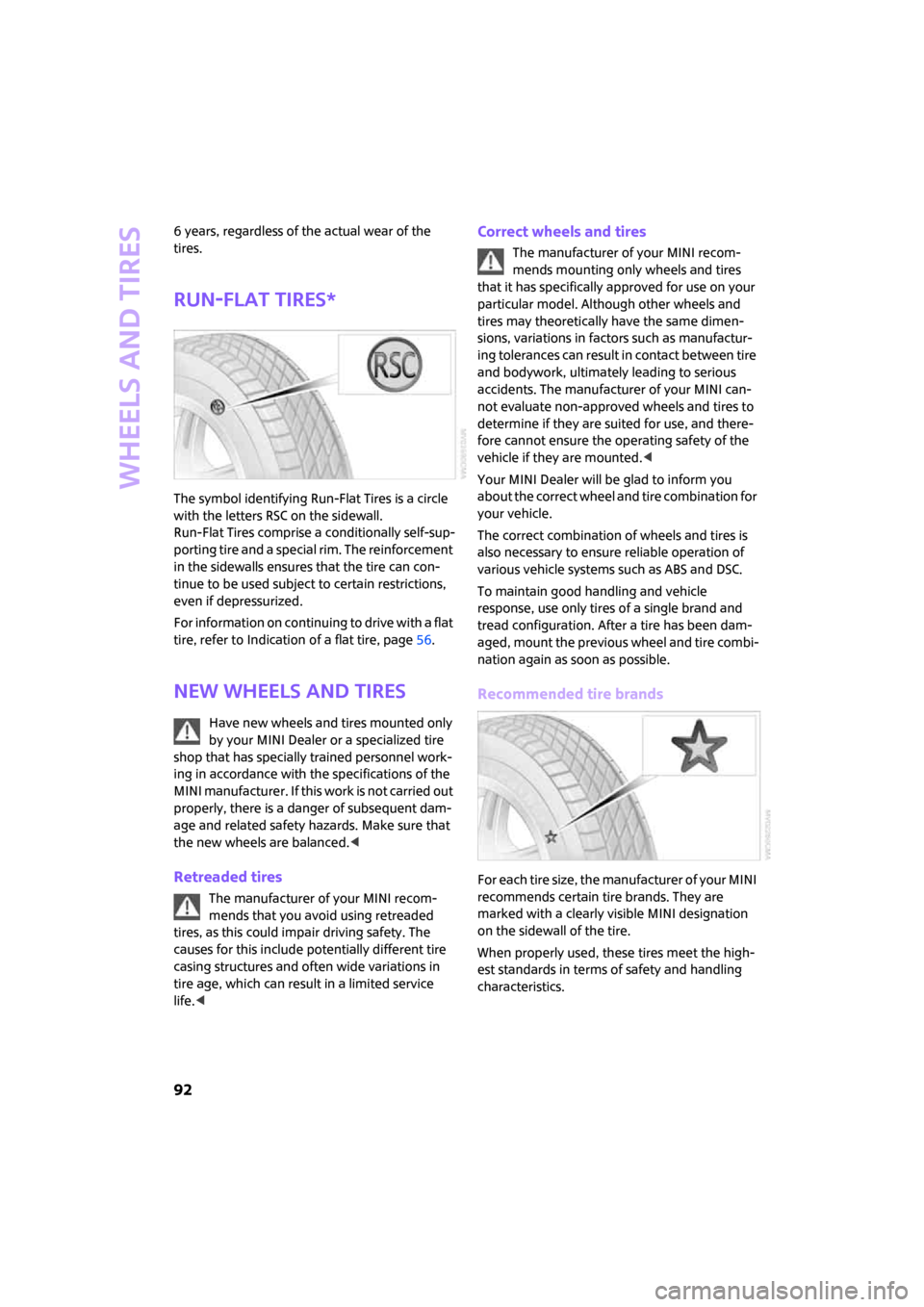
Wheels and tires
92
6 years, regardless of the actual wear of the
tires.
Run-Flat Tires*
The symbol identifying Run-Flat Tires is a circle
with the letters RSC on the sidewall.
Run-Flat Tires comprise a conditionally self-sup-
porting tire and a special rim. The reinforcement
in the sidewalls ensures that the tire can con-
tinue to be used subject to certain restrictions,
even if depressurized.
For information on continuing to drive with a flat
tire, refer to Indication of a flat tire, page56.
New wheels and tires
Have new wheels and tires mounted only
by your MINI Dealer or a specialized tire
shop that has specially trained personnel work-
ing in accordance with the specifications of the
MINI manufacturer. If this work is not carried out
properly, there is a danger of subsequent dam-
age and related safety hazards. Make sure that
the new wheels are balanced.<
Retreaded tires
The manufacturer of your MINI recom-
mends that you avoid using retreaded
tires, as this could impair driving safety. The
causes for this include potentially different tire
casing structures and often wide variations in
tire age, which can result in a limited service
life.<
Correct wheels and tires
The manufacturer of your MINI recom-
mends mounting only wheels and tires
that it has specifically approved for use on your
particular model. Although other wheels and
tires may theoretically have the same dimen-
sions, variations in factors such as manufactur-
ing tolerances can result in contact between tire
and bodywork, ultimately leading to serious
accidents. The manufacturer of your MINI can-
not evaluate non-approved wheels and tires to
determine if they are suited for use, and there-
fore cannot ensure the operating safety of the
vehicle if they are mounted.<
Your MINI Dealer will be glad to inform you
about the correct wheel and tire combination for
your vehicle.
The correct combination of wheels and tires is
also necessary to ensure reliable operation of
various vehicle systems such as ABS and DSC.
To maintain good handling and vehicle
response, use only tires of a single brand and
tread configuration. After a tire has been dam-
aged, mount the previous wheel and tire combi-
nation again as soon as possible.
Recommended tire brands
For each tire size, the manufacturer of your MINI
recommends certain tire brands. They are
marked with a clearly visible MINI designation
on the sidewall of the tire.
When properly used, these tires meet the high-
est standards in terms of safety and handling
characteristics.
Page 111 of 148
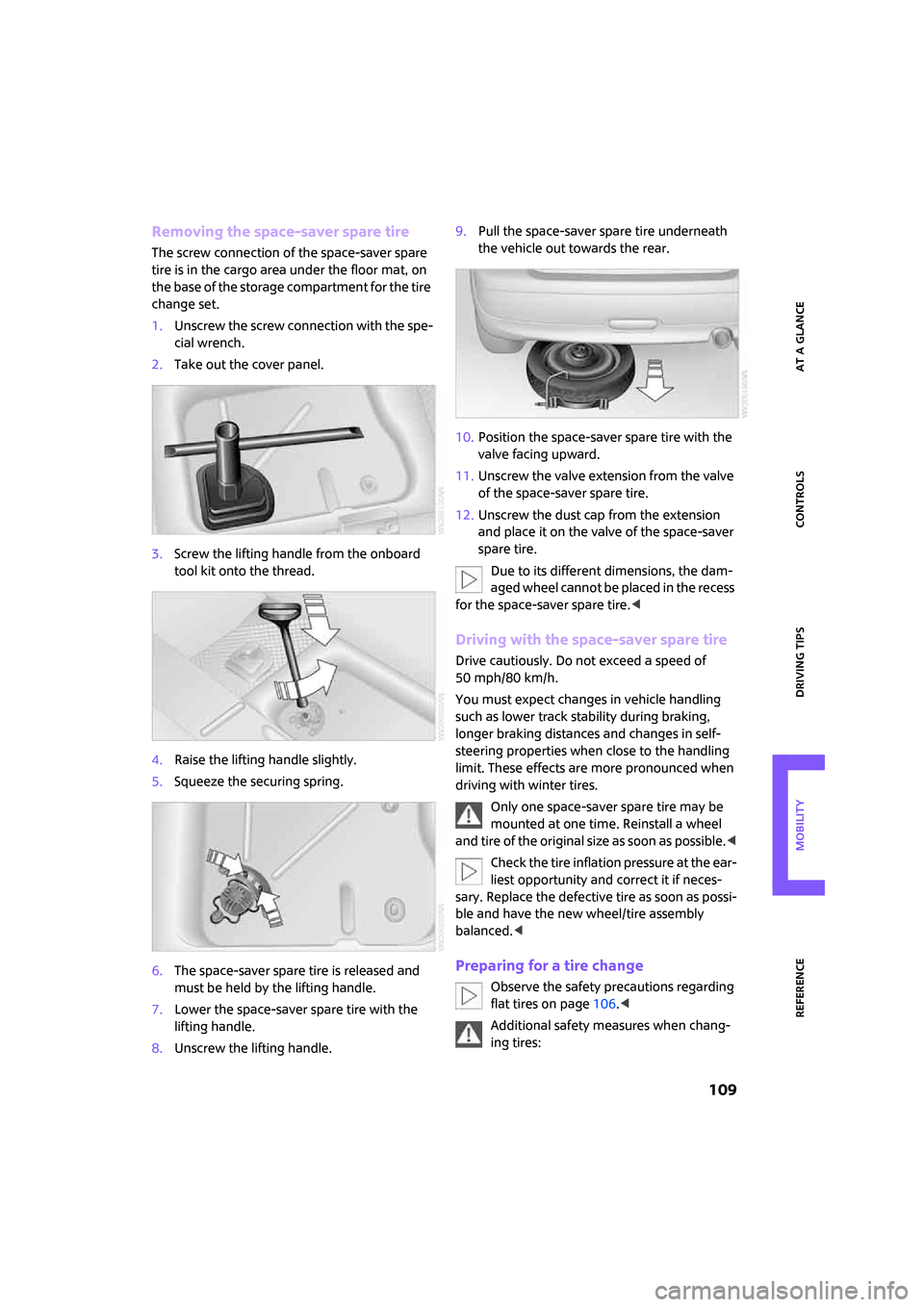
ReferenceAt a glance Controls Driving tips Mobility
109
Removing the space-saver spare tire
The screw connection of the space-saver spare
tire is in the cargo area under the floor mat, on
the base of the storage compartment for the tire
change set.
1.Unscrew the screw connection with the spe-
cial wrench.
2.Take out the cover panel.
3.Screw the lifting handle from the onboard
tool kit onto the thread.
4.Raise the lifting handle slightly.
5.Squeeze the securing spring.
6.The space-saver spare tire is released and
must be held by the lifting handle.
7.Lower the space-saver spare tire with the
lifting handle.
8.Unscrew the lifting handle.9.Pull the space-saver spare tire underneath
the vehicle out towards the rear.
10.Position the space-saver spare tire with the
valve facing upward.
11.Unscrew the valve extension from the valve
of the space-saver spare tire.
12.Unscrew the dust cap from the extension
and place it on the valve of the space-saver
spare tire.
Due to its different dimensions, the dam-
aged wheel cannot be placed in the recess
for the space-saver spare tire.<
Driving with the space-saver spare tire
Drive cautiously. Do not exceed a speed of
50 mph/80 km/h.
You must expect changes in vehicle handling
such as lower track stability during braking,
longer braking distances and changes in self-
steering properties when close to the handling
limit. These effects are more pronounced when
driving with winter tires.
Only one space-saver spare tire may be
mounted at one time. Reinstall a wheel
and tire of the original size as soon as possible.<
Check the tire inflation pressure at the ear-
liest opportunity and correct it if neces-
sary. Replace the defective tire as soon as possi-
ble and have the new wheel/tire assembly
balanced.<
Preparing for a tire change
Observe the safety precautions regarding
flat tires on page106.<
Additional safety measures when chang-
ing tires:
Page 143 of 148
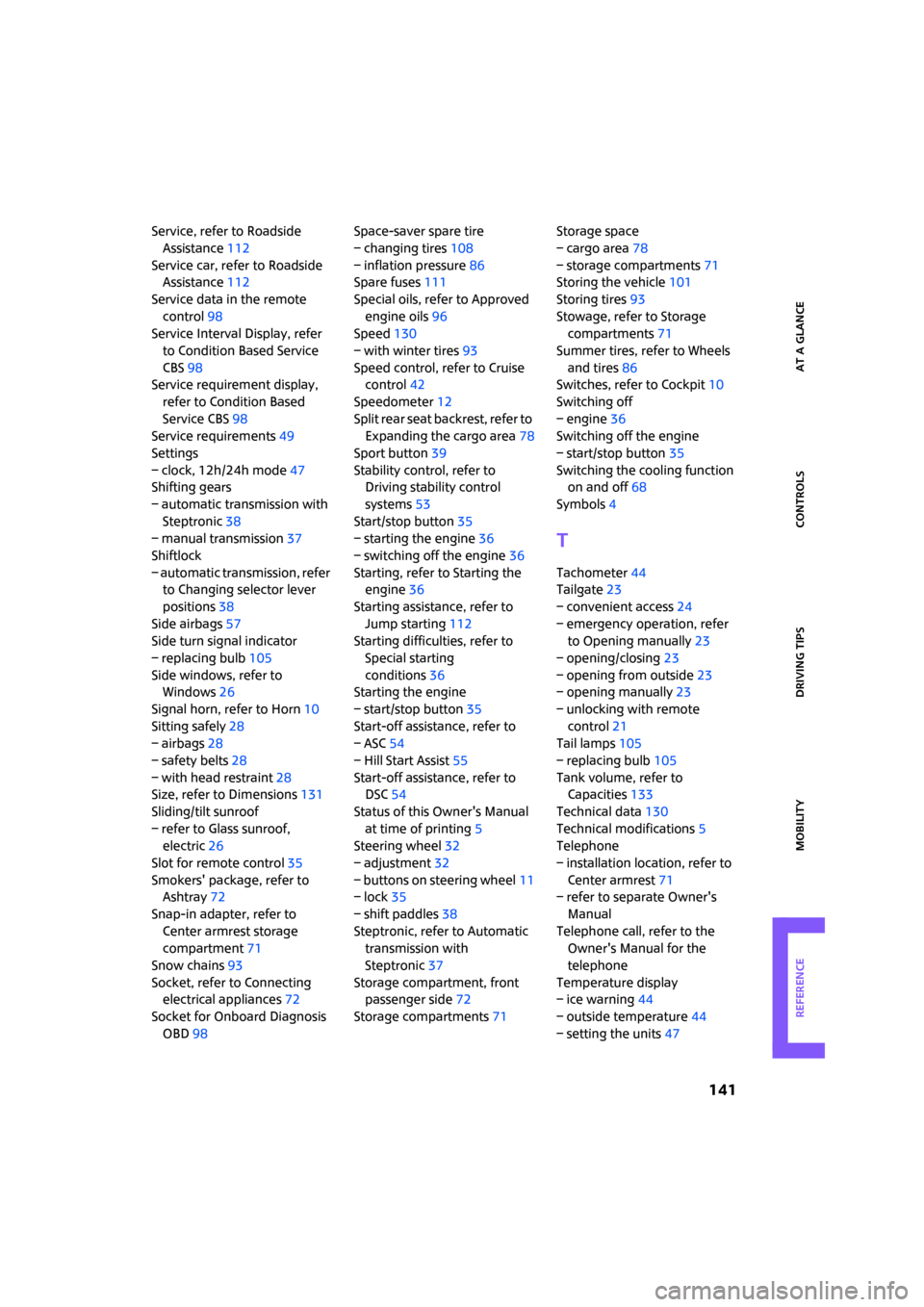
ReferenceAt a glance Controls Driving tips Mobility
141
Service, refer to Roadside
Assistance112
Service car, refer to Roadside
Assistance112
Service data in the remote
control98
Service Interval Display, refer
to Condition Based Service
CBS98
Service requirement display,
refer to Condition Based
Service CBS98
Service requirements49
Settings
– clock, 12h/24h mode47
Shifting gears
– automatic transmission with
Steptronic38
– manual transmission37
Shiftlock
– automatic transmission, refer
to Changing selector lever
positions38
Side airbags57
Side turn signal indicator
– replacing bulb105
Side windows, refer to
Windows26
Signal horn, refer to Horn10
Sitting safely28
– airbags28
– safety belts28
– with head restraint28
Size, refer to Dimensions131
Sliding/tilt sunroof
– refer to Glass sunroof,
electric26
Slot for remote control35
Smokers' package, refer to
Ashtray72
Snap-in adapter, refer to
Center armrest storage
compartment71
Snow chains93
Socket, refer to Connecting
electrical appliances72
Socket for Onboard Diagnosis
OBD98Space-saver spare tire
– changing tires108
– inflation pressure86
Spare fuses111
Special oils, refer to Approved
engine oils96
Speed130
– with winter tires93
Speed control, refer to Cruise
control42
Speedometer12
Split rear seat backrest, refer to
Expanding the cargo area78
Sport button39
Stability control, refer to
Driving stability control
systems53
Start/stop button35
– starting the engine36
– switching off the engine36
Starting, refer to Starting the
engine36
Starting assistance, refer to
Jump starting112
Starting difficulties, refer to
Special starting
conditions36
Starting the engine
– start/stop button35
Start-off assistance, refer to
– ASC54
– Hill Start Assist55
Start-off assistance, refer to
DSC54
Status of this Owner's Manual
at time of printing5
Steering wheel32
– adjustment32
– buttons on steering wheel11
– lock35
– shift paddles38
Steptronic, refer to Automatic
transmission with
Steptronic37
Storage compartment, front
passenger side72
Storage compartments71Storage space
– cargo area78
– storage compartments71
Storing the vehicle101
Storing tires93
Stowage, refer to Storage
compartments71
Summer tires, refer to Wheels
and tires86
Switches, refer to Cockpit10
Switching off
– engine36
Switching off the engine
– start/stop button35
Switching the cooling function
on and off68
Symbols4T
Tachometer44
Tailgate23
– convenient access24
– emergency operation, refer
to Opening manually23
– opening/closing23
– opening from outside23
– opening manually23
– unlocking with remote
control21
Tail lamps105
– replacing bulb105
Tank volume, refer to
Capacities133
Technical data130
Technical modifications5
Telephone
– installation location, refer to
Center armrest71
– refer to separate Owner's
Manual
Telephone call, refer to the
Owner's Manual for the
telephone
Temperature display
– ice warning44
– outside temperature44
– setting the units47
Page 144 of 148
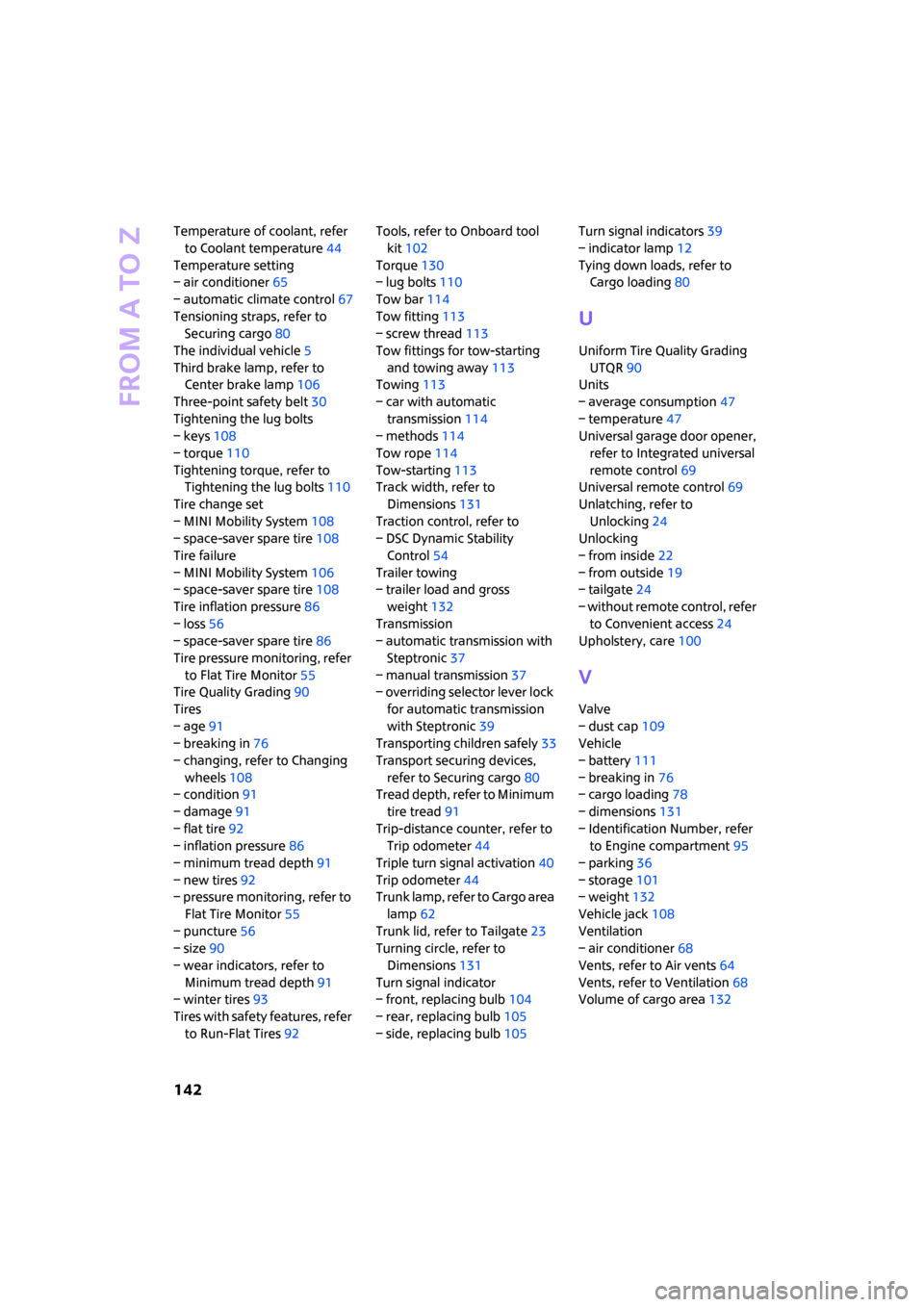
From A to Z
142
Temperature of coolant, refer
to Coolant temperature44
Temperature setting
– air conditioner65
– automatic climate control67
Tensioning straps, refer to
Securing cargo80
The individual vehicle5
Third brake lamp, refer to
Center brake lamp106
Three-point safety belt30
Tightening the lug bolts
– keys108
– torque110
Tightening torque, refer to
Tightening the lug bolts110
Tire change set
– MINI Mobility System108
– space-saver spare tire108
Tire failure
– MINI Mobility System106
– space-saver spare tire108
Tire inflation pressure86
– loss56
– space-saver spare tire86
Tire pressure monitoring, refer
to Flat Tire Monitor55
Tire Quality Grading90
Tires
– age91
– breaking in76
– changing, refer to Changing
wheels108
– condition91
– damage91
– flat tire92
– inflation pressure86
– minimum tread depth91
– new tires92
– pressure monitoring, refer to
Flat Tire Monitor55
– puncture56
– size90
– wear indicators, refer to
Minimum tread depth91
– winter tires93
Tires with safety features, refer
to Run-Flat Tires92Tools, refer to Onboard tool
kit102
Torque130
– lug bolts110
Tow bar114
Tow fitting113
– screw thread113
Tow fittings for tow-starting
and towing away113
Towing113
– car with automatic
transmission114
– methods
114
Tow rope114
Tow-starting113
Track width, refer to
Dimensions131
Traction control, refer to
– DSC Dynamic Stability
Control54
Trailer towing
– trailer load and gross
weight132
Transmission
– automatic transmission with
Steptronic37
– manual transmission37
– overriding selector lever lock
for automatic transmission
with Steptronic39
Transporting children safely33
Transport securing devices,
refer to Securing cargo80
Tread depth, refer to Minimum
tire tread91
Trip-distance counter, refer to
Trip odometer44
Triple turn signal activation40
Trip odometer44
Trunk lamp, refer to Cargo area
lamp62
Trunk lid, refer to Tailgate23
Turning circle, refer to
Dimensions131
Turn signal indicator
– front, replacing bulb104
– rear, replacing bulb105
– side, replacing bulb105Turn signal indicators39
– indicator lamp12
Tying down loads, refer to
Cargo loading80
U
Uniform Tire Quality Grading
UTQR90
Units
– average consumption47
– temperature47
Universal garage door opener,
refer to Integrated universal
remote control69
Universal remote control69
Unlatching, refer to
Unlocking24
Unlocking
– from inside22
– from outside19
– tailgate24
– without remote control, refer
to Convenient access24
Upholstery, care100
V
Valve
– dust cap109
Vehicle
– battery111
– breaking in76
– cargo loading78
– dimensions131
– Identification Number, refer
to Engine compartment95
– parking36
– storage101
– weight132
Vehicle jack108
Ventilation
– air conditioner68
Vents, refer to Air vents64
Vents, refer to Ventilation68
Volume of cargo area132